I’m just back from Tsuke Edomae in Austin and had to tell you about it.
I love great sushi and I’ll travel for it, though with the pandemic it’s been awhile since I’ve had the chance for a Tokyo sushi tour.
When I moved to Austin I got great barbecue, but traded Northern Virginia’s good Asian food in exchange. There’s ok Vietnamese food, pretty good ramen, and mostly bad Thai. The one area where Austin rates in Japanese, though it’s only in the past six years that this has become true.
I was thrilled to the moon when omakase restaurant Kyoten Sushiko opened in 2016. I suggested readers ‘go now’ and I said at the time Chef Otto Phan wouldn’t stay in Austin. It wasn’t a big enough stage. He didn’t. He moved to Chicago serving outstanding omakase sushi there. He’s serving truly amazing fish at a mind-boggling price point now ($440 per person during the week, $490 on Friday and Saturday nights, inclusive of gratuity) – double what he was charging after doubling with his move from Austin to Chicago.
I’ve been a huge fan of Chef Phan’s. My wife and I were regulars when he was in Austin, at one point with his telling us we needed to come a little less often so he could get better in-between our meals. We’ve been up to his Chicago restaurant three times, most recently for our anniversary – which was also re-creating what was the very first trip we’d cancelled due to Covid back in March 2020.
Fortunately Chef Phan’s old Kyoten space in Austin is now Tsuke Edomae, chef Michael Che’s take on traditional omakase sushi. He describes Chef Otto as his Master, serves the same rice, and has access to the same fish purveyor. And it’s at a much more affordable $99++ price point.
Chef Che has some distance to go before offering a similar experience to Phan’s Kyoten, but he’s already doing incredibly well. By one measure – Tock waitlist – he has the most in-demand restaurant in the United States right now.
My First Meal At Tsuke Edomae In Austin
Tsuke Edomae is inside a relatively unadorned storefront in the Mueller neighborhood of Austin. Enter and there’s fake grass on the floor. When your meal is ready to begin, however, you’ll be taken inside to the sushi counter and that’s when you’ve truly arrived. There are 8 seats, a chef, and one server who will bring you drinks and assist the chef in retrieving some items over the course of two and a half to three hours.
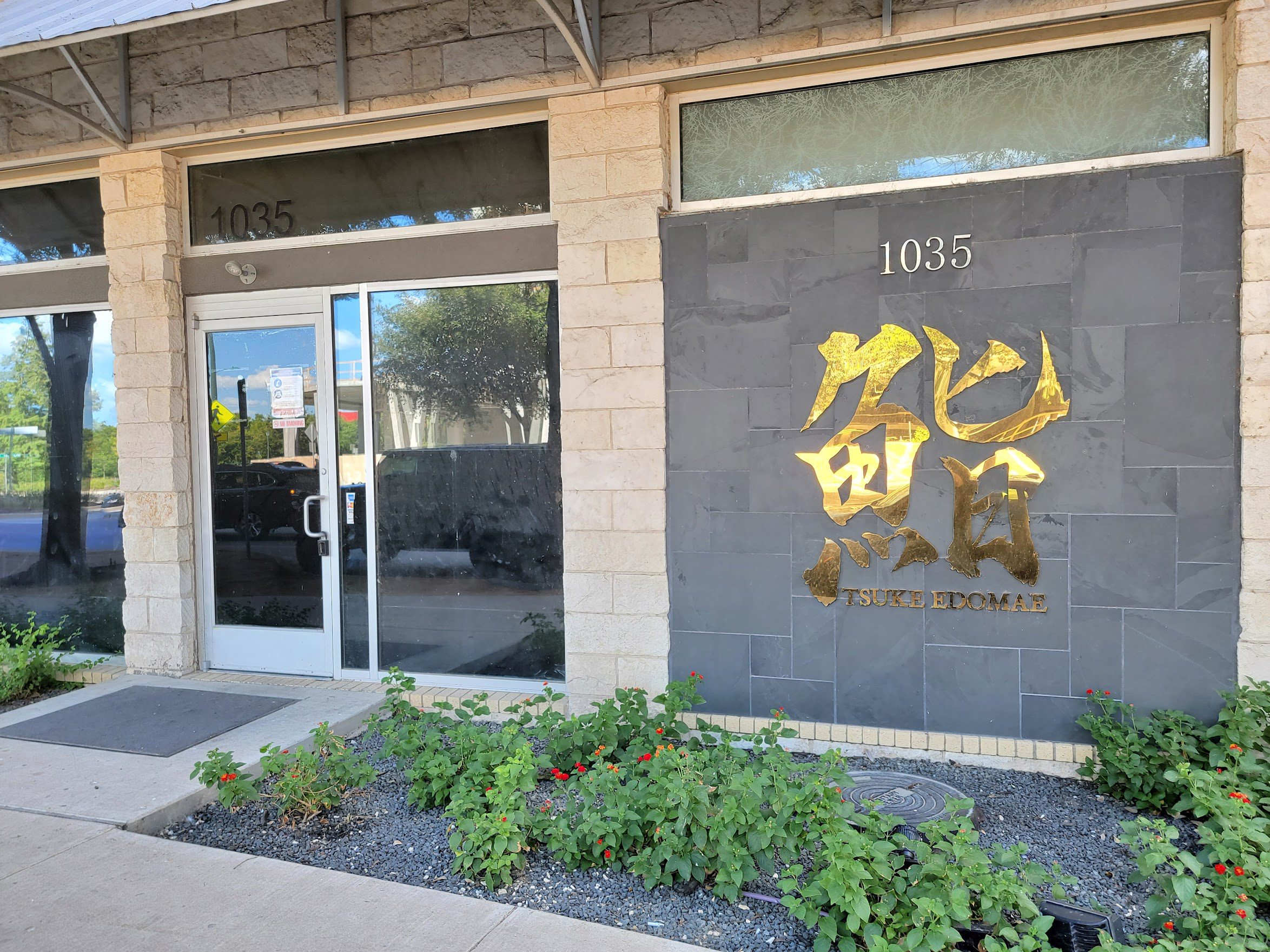
The meal is a price fixe omakase for $99. Tax and gratuity are additional. Prior to dessert courses you’ll be given an opportunity to order additional fish items – either repeats of some of the pieces you’ve already tried, or a few that weren’t on the evening’s menu.
I made this booking about three months in advance, so I was really looking forward to it. Reservations will drop usually for a three month period one morning and they’re scooped up almost immediately.
Here Chef Che is presenting the evening’s otoro or fatty tuna before he cuts it. Often in restaurants I’ve been shown food whole and uncooked, and then actually given different food. This was the tuna we’d be having in just a little while.
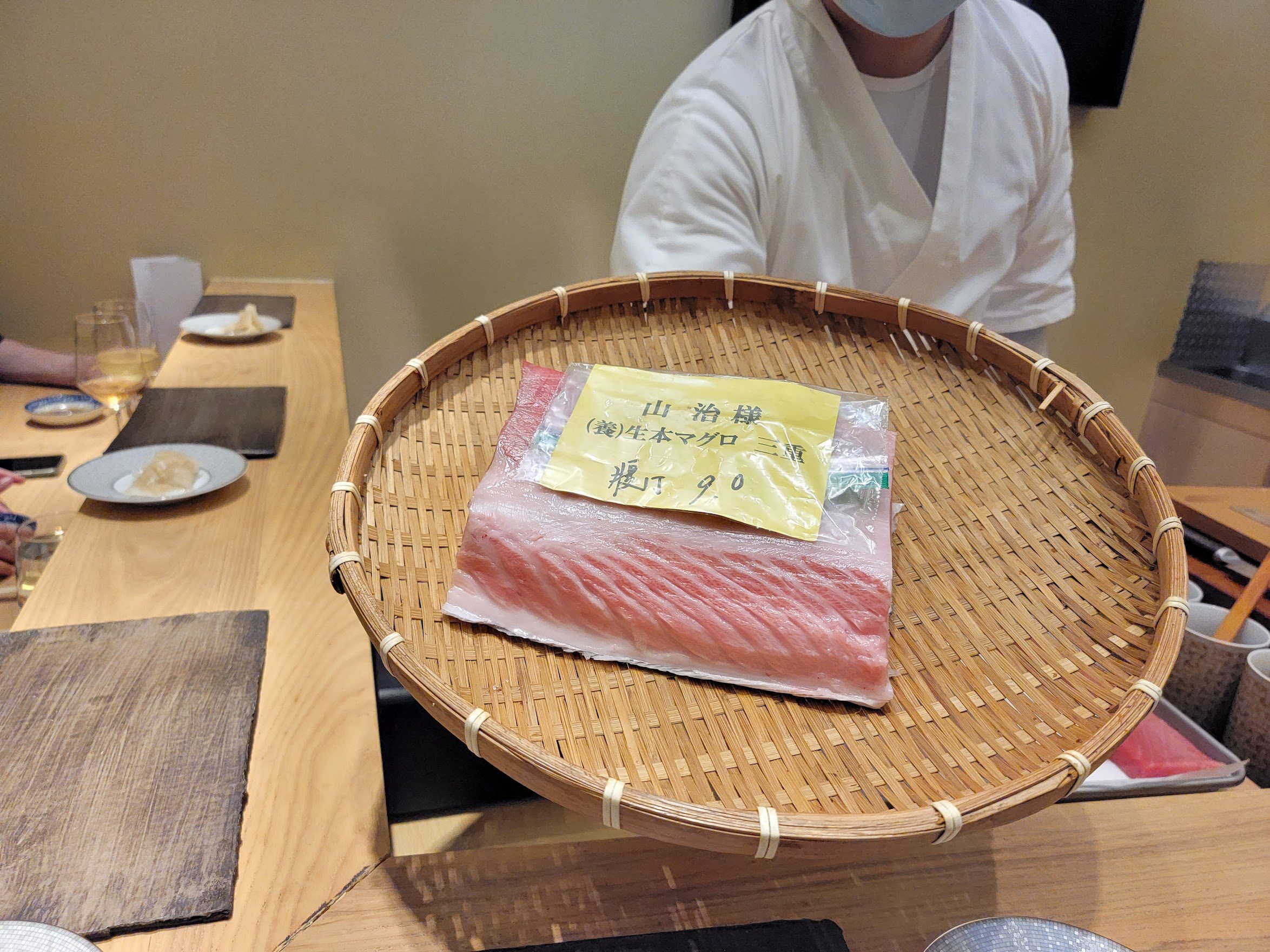
Here was some of the other fish we’d be served. I think the chef Che is still learning his craft and developing his speed. In order to get pieces of fish out quickly to all 8 guests, he cut several fish courses in front of us in advance rather than cutting pieces and serving them immediately. The rice, however, in each case was fresh and hot (and he replaces the rice every 45 minutes).
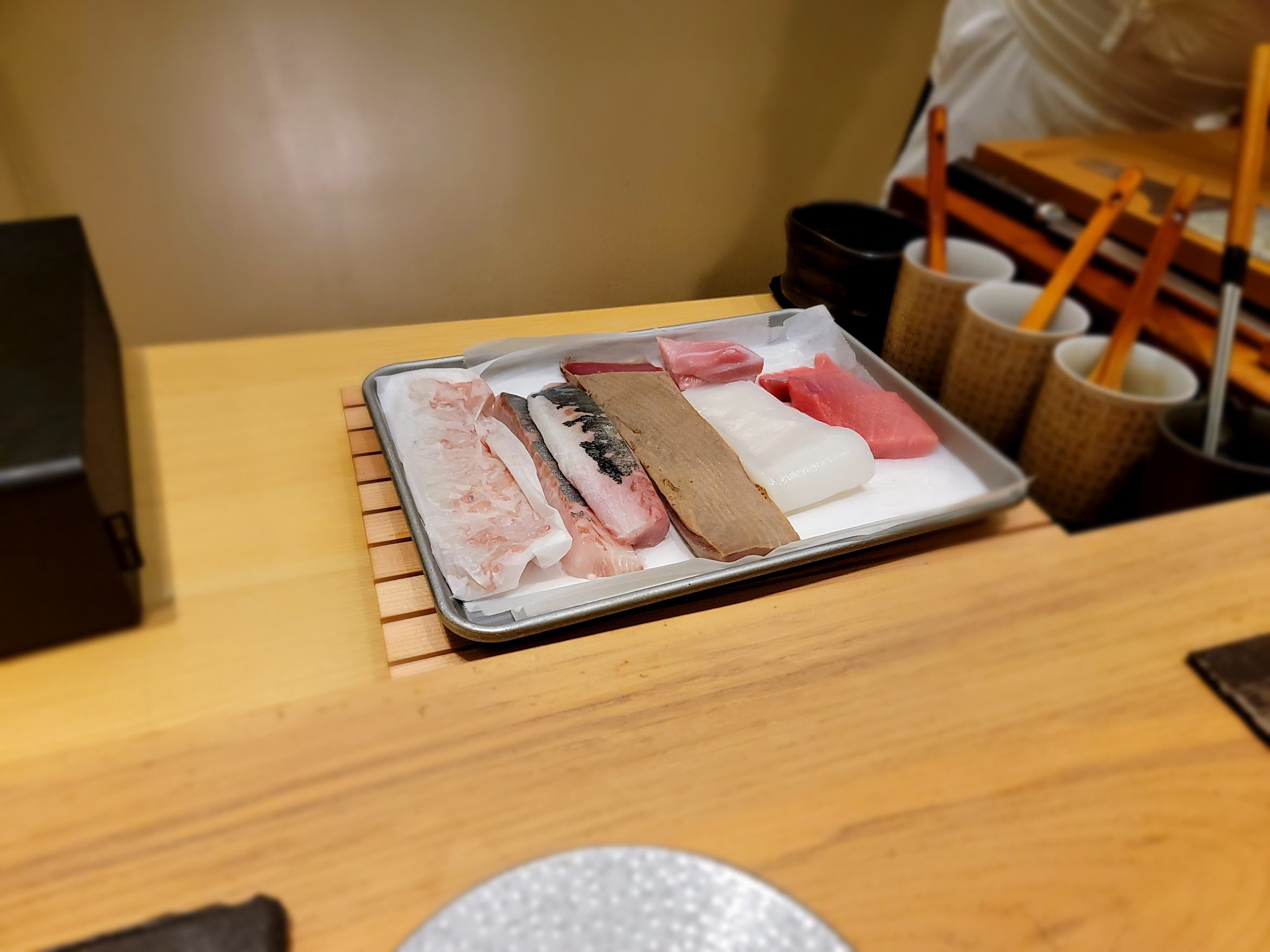
Chef Che began the meal explaining how to eat sushi properly, offering several rules. It’s quite common for diners not to be experienced in this, and a decade ago I wouldn’t have been either. He explains that each piece must be eaten within 15 seconds of being presented – that by the time the next guest has a piece it should be gone. He wants you to eat with your fingers in a single bite, and reminds that the ginger is at each place as a palate cleanser between pieces and not to add to the nigiri.
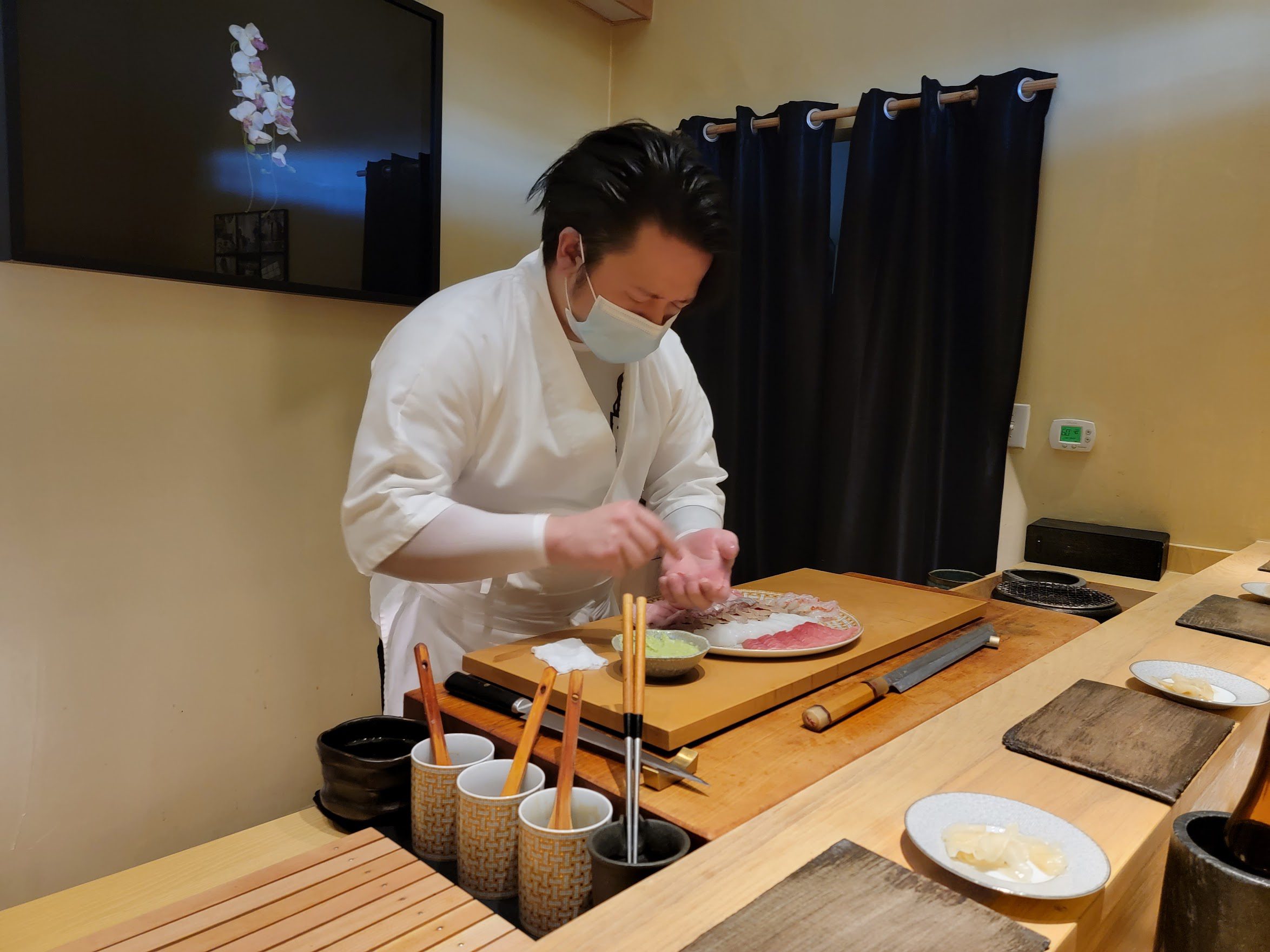
Here’s the squid, and I found the texture to be remarkable. On the one hand the cuts he gave it created a contrast between the outside of the fish and the inside and I enjoyed it, while my wife found it distracting.
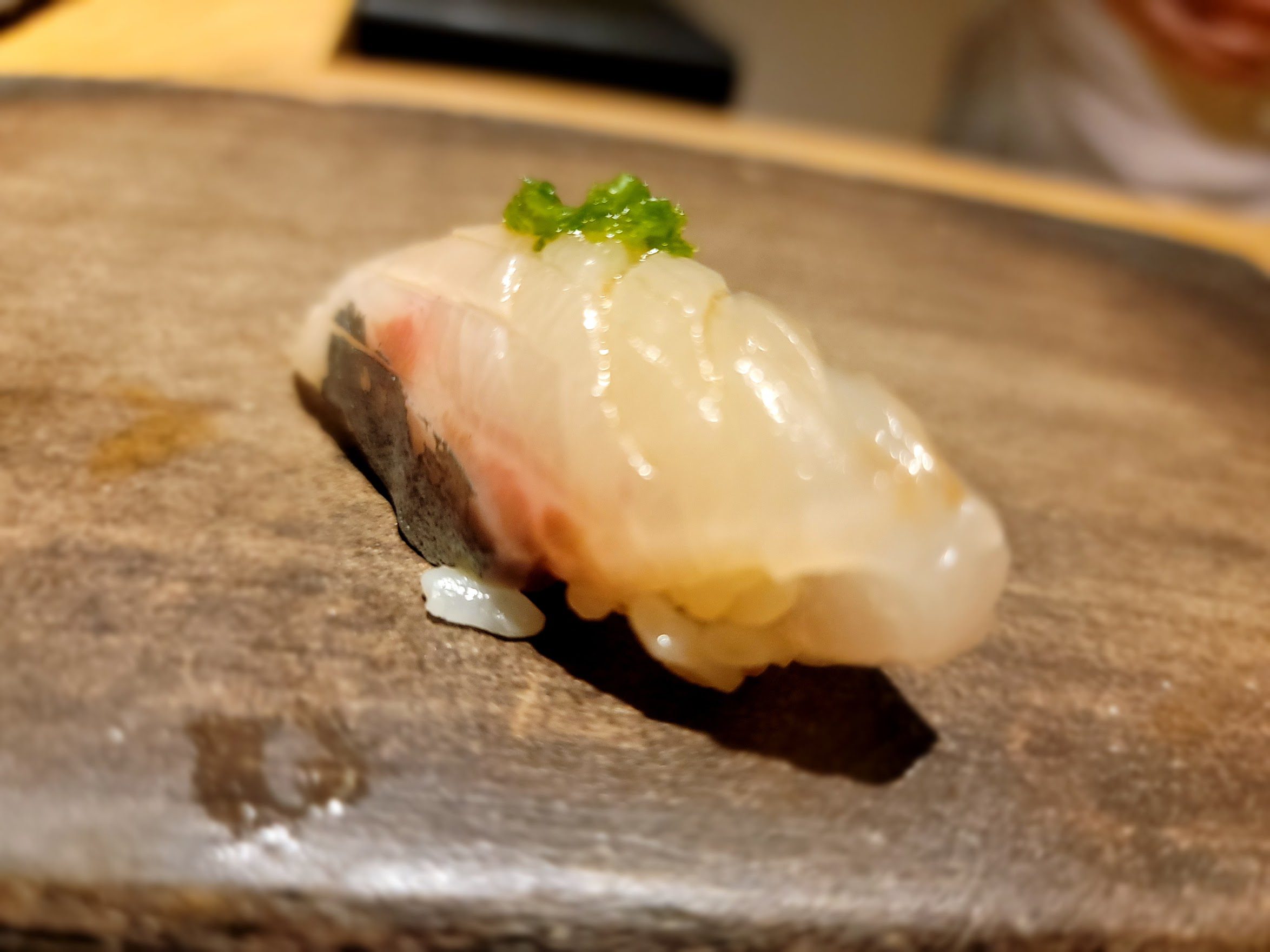
I very much enjoyed the chutoro, perhaps my favorite cut of tuna. It’s rich and decadent, but less fatty than otoro.
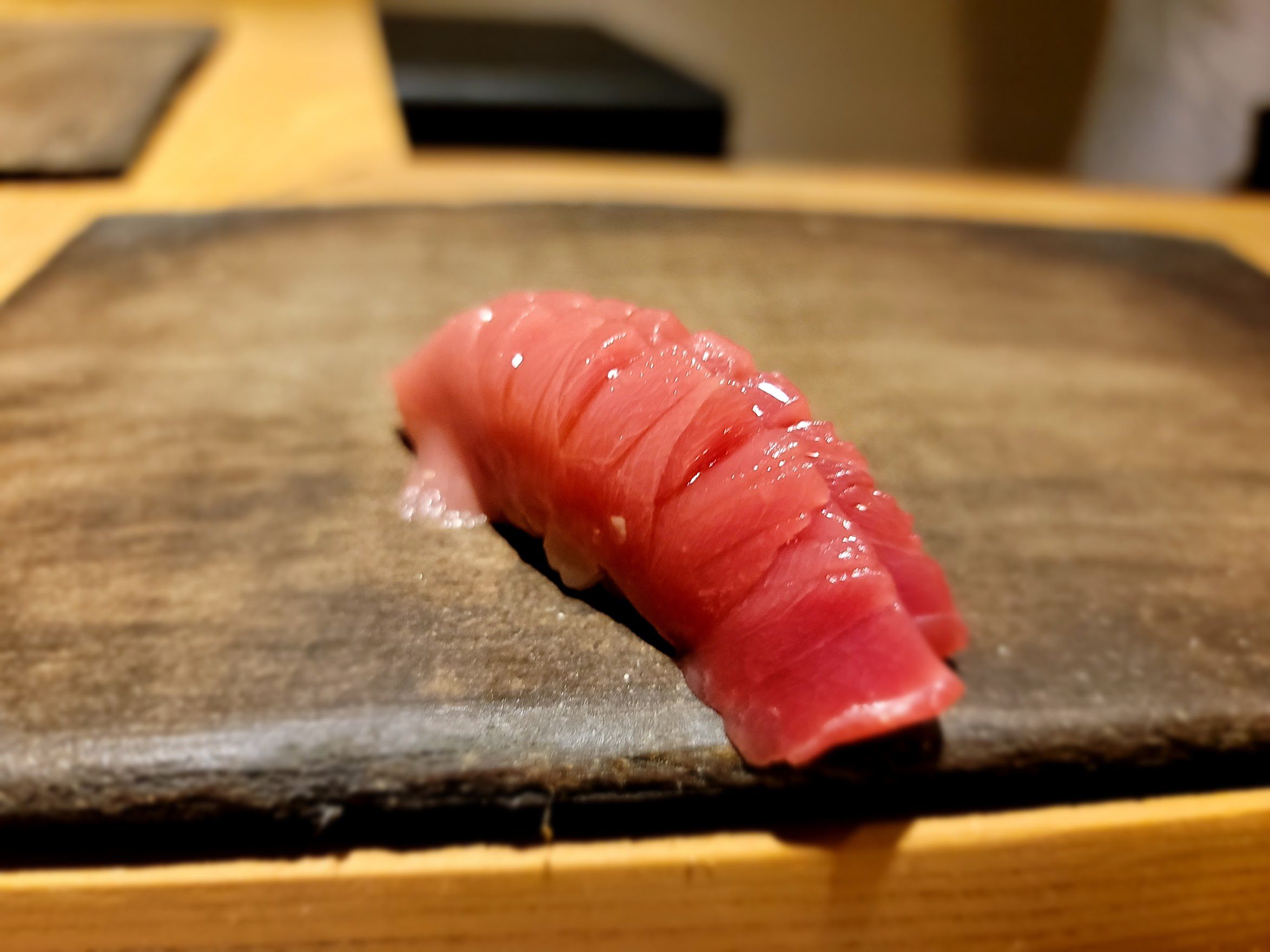
Chef Che smoked the fatty tuna over a grill before serving it. It basted in its own fat, essentially. He also served a magnificent crab.
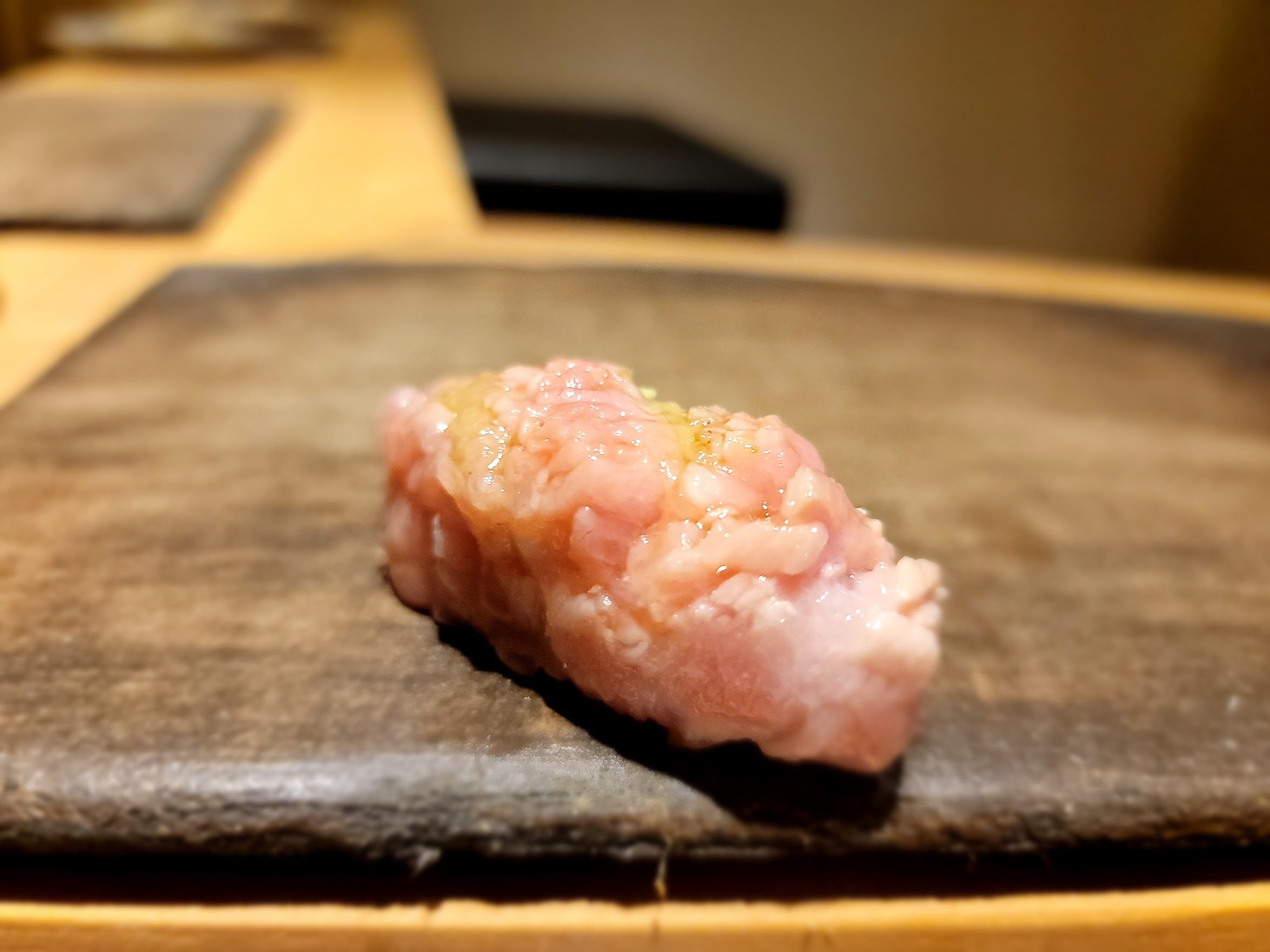
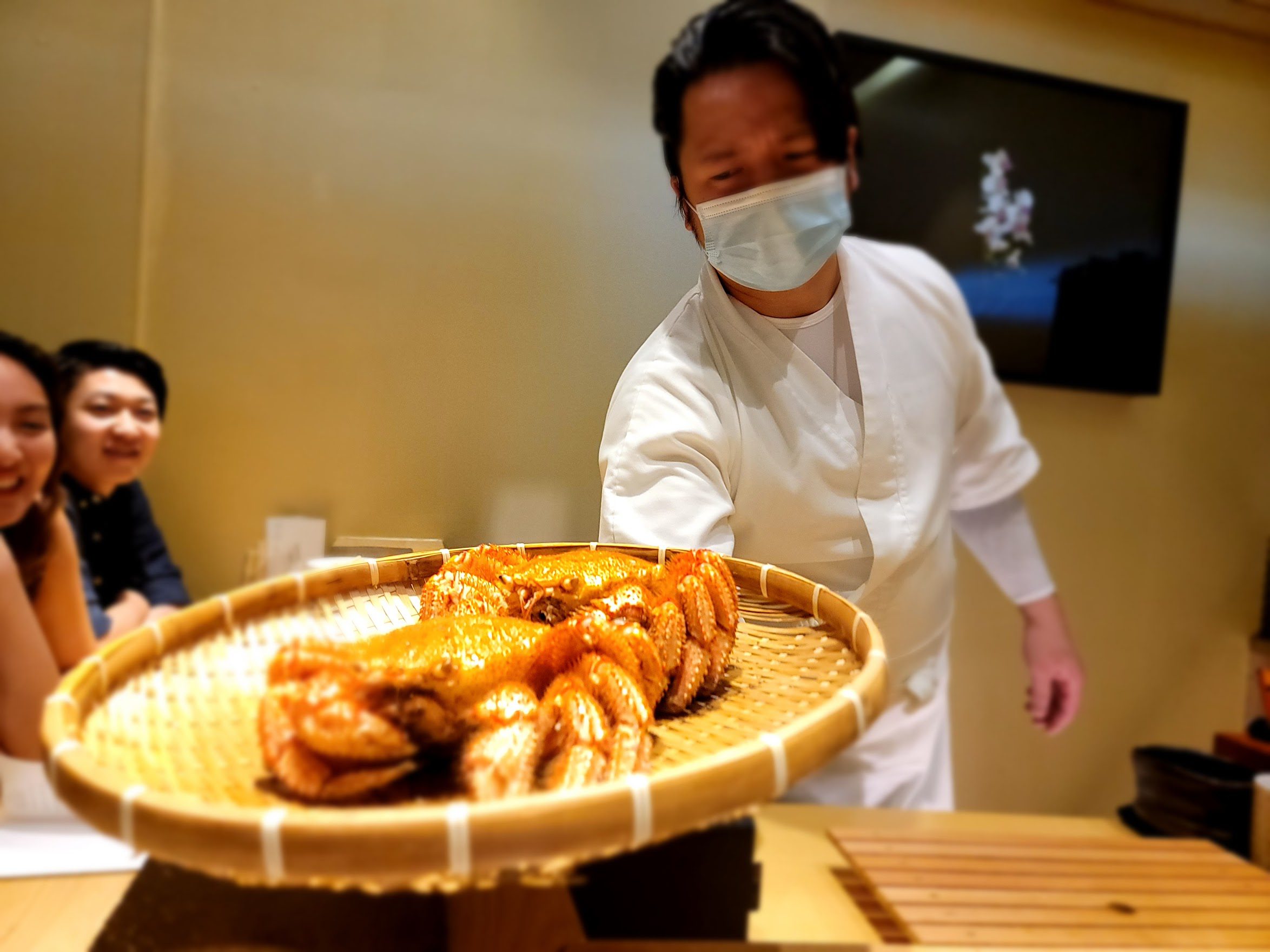
I did find that the pieces of fish were sliced thinly overall, logical given the $99 price point. And I would have enjoyed more rice with each piece of nigiri. He uses a special rice only served elsewhere by Kyoten in the United States. But I felt he used probably too much vinegar with the rice so it didn’t hold together as well as Chef Otto’s.
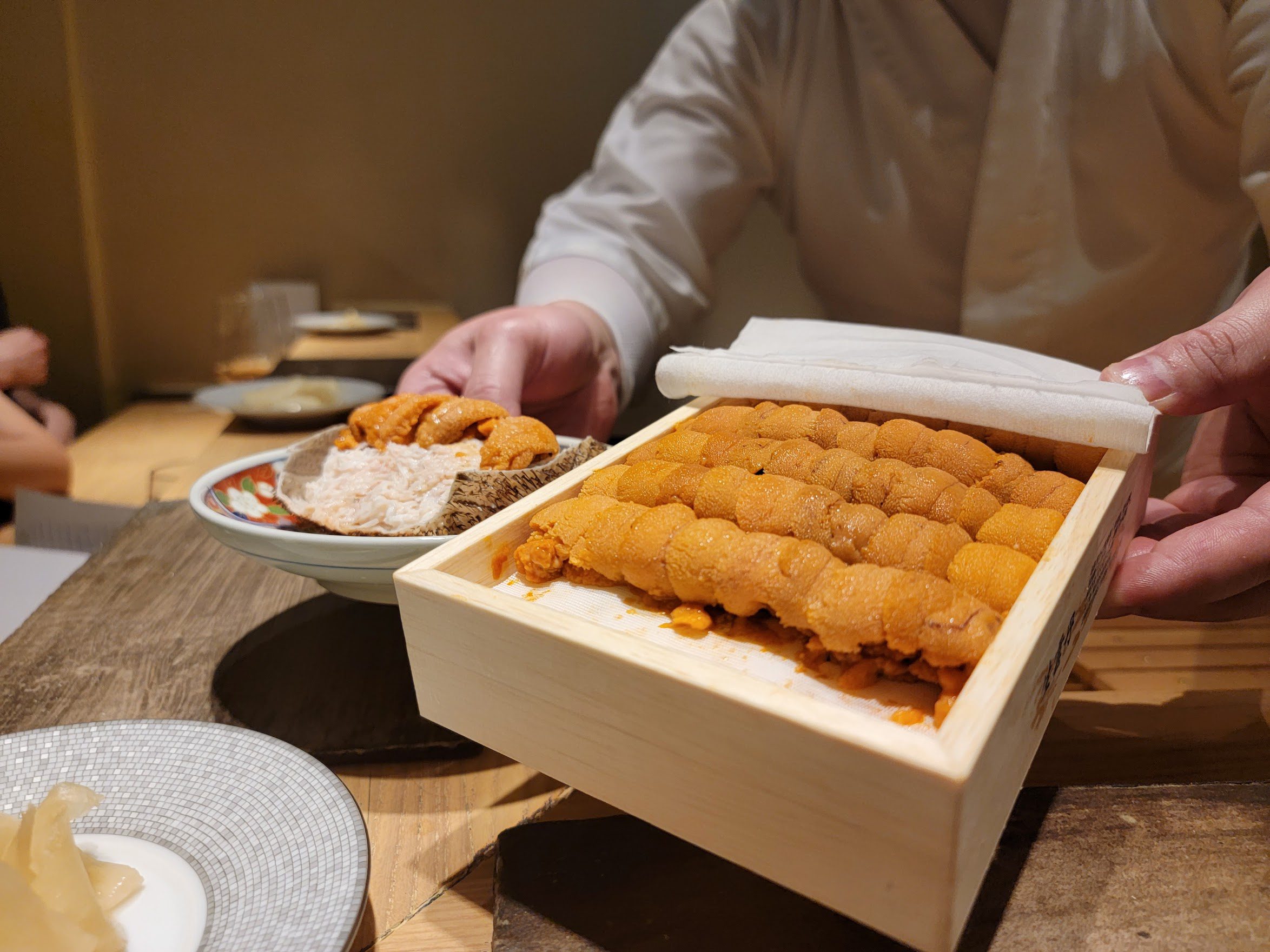
Tsuke Edomae draws its name from the chef’s past endeavors. Immediately before opening his omakase restaurant he ran Tsuke Honten as a Japanese food truck followed by a brick and mortar. He began the omakase with a salad though I’d love it if he brought in some of the noodles from his past endeavor as an homage, which I think might strike a more personal note to start the meal.
The chef plays classical music during part of the meal. He finds it inspirational and he’s clearly passionate. He’ll also turn down the lights. I’m not certain these things are necessary and I even found them a bit distracting, but they communicate his passion and can’t hurt to experiment with. I also found it a miss not to offer finger wipes considering that the nigiri is to be eaten by hand.
Chef Che is not expensive enough given the difficulty of getting a reservation (raise price, he’d make more and still fill up), but the price point makes sense – and makes him popular! – for the fish on offer. He’s closing down Tsuke Edomae for six months starting in December while he studies sushi under a chef in Japan. I am excited to try the restaurant again shortly before he leaves, and then once he returns, in order to see the difference.
Get To Kyoten In Chicago As Well
If you’re in Chicago, or can get a reservation and are able to travel to Chicago, and you can afford it – go to Kyoten. Chef Phan has gotten even better, and his fish has gotten better. He’s no longer doing two seatings per night. There’s just one intimate seating around his sushi counter now, and the meal lasts three hours. His fish is incredible.
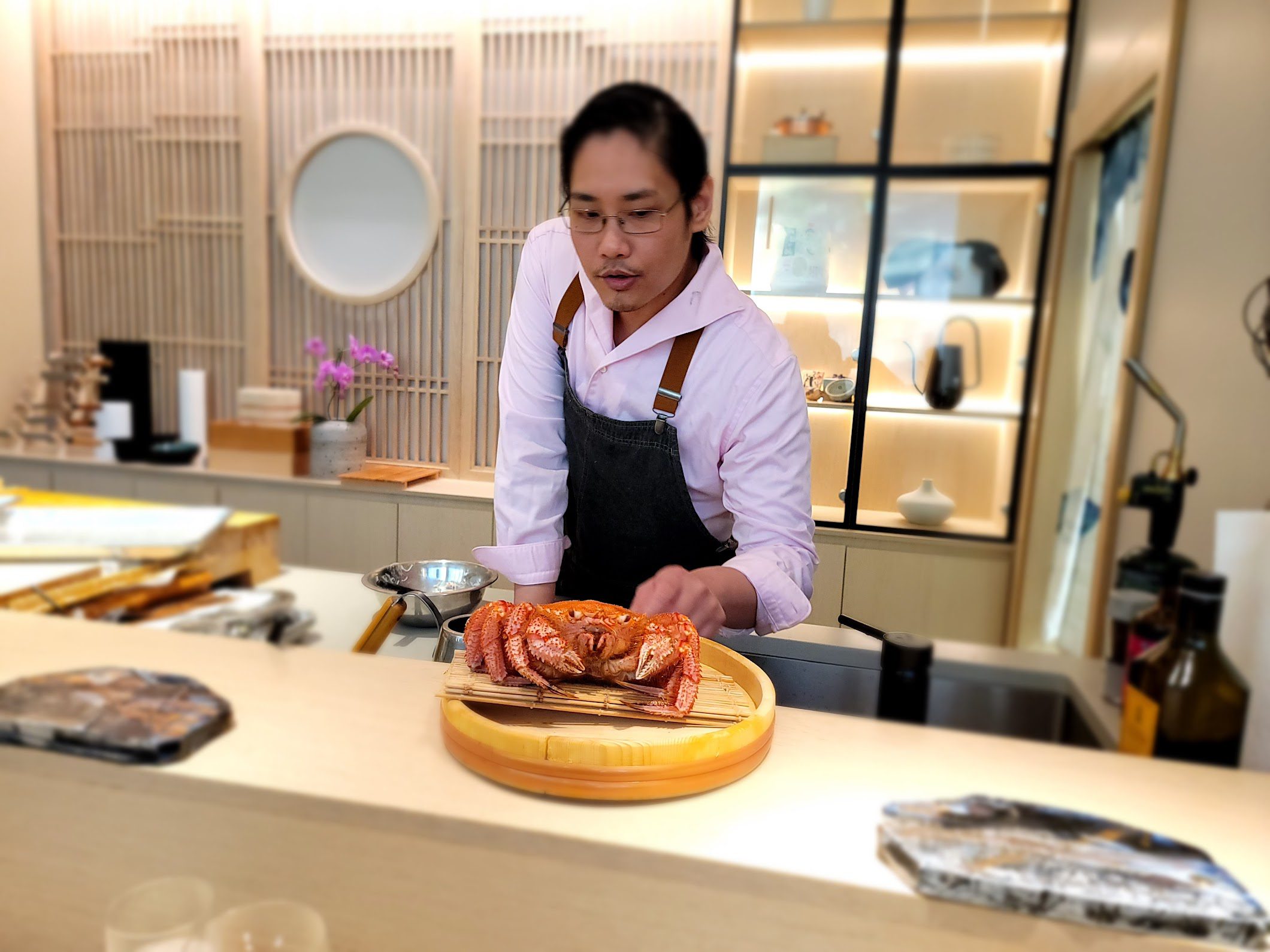
Unlike Tsuke Edomae he does not present a menu. It’s a practice he ceased when he was still in Austin. That’s because he changes his mind during the meal about what he’s going to serve – the meal isn’t just what fish was best that day, but what turns out to be best in the moment. It’s based on what is working for that evening’s meal. And it’s based on his inspiration.
He’s always thinking about how things pair and progress and may want to experiment and try something different that he hadn’t even anticipated. This isn’t a rote experience that’s the same night after night both because the unique pieces of fish he can get change, but also because he’s constantly being inspired to try new things.
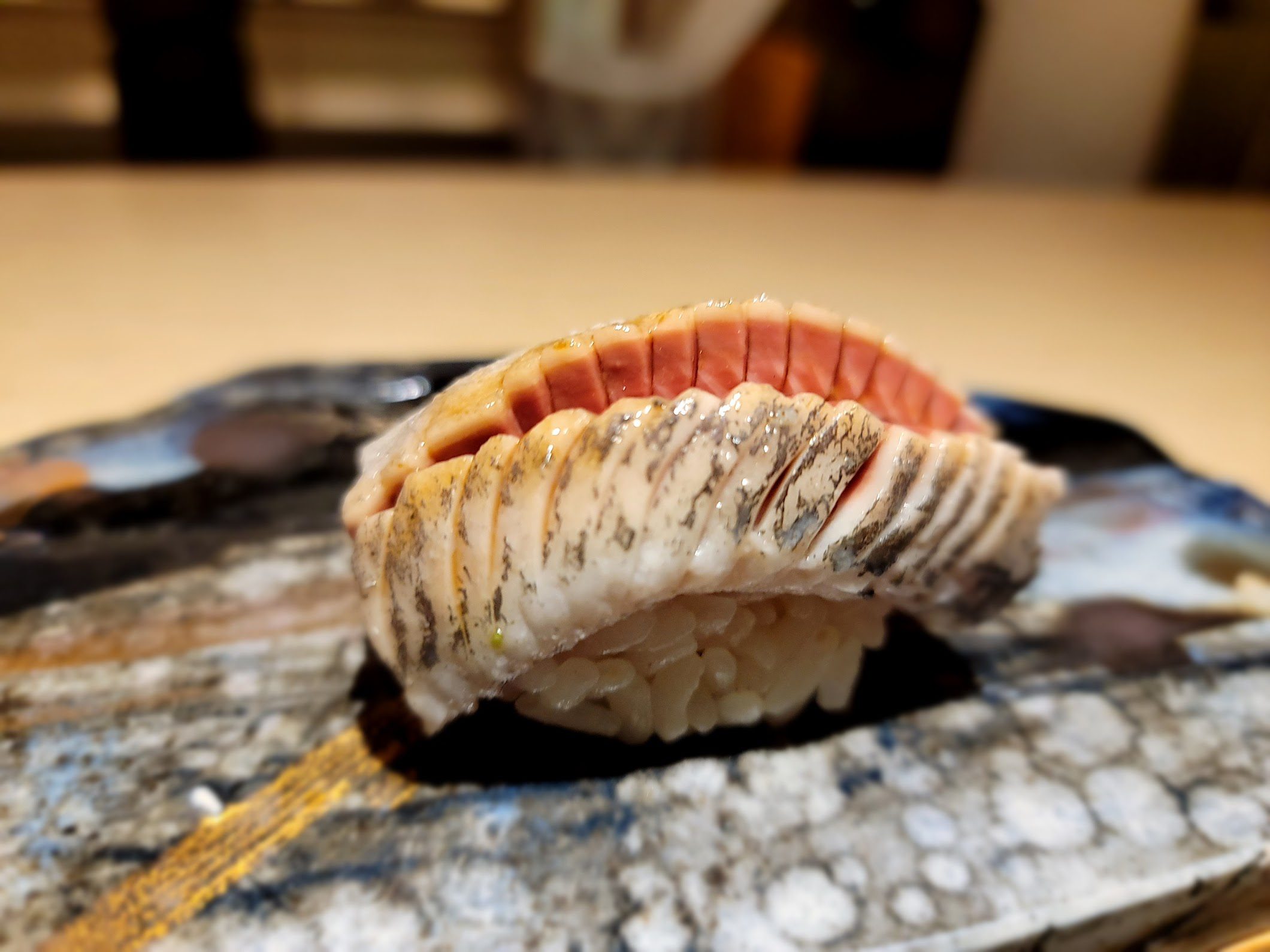
That also means that some meals or some pieces won’t appeal as much on a given night. We were lucky – one of my favorite pieces that he serves has been Alabama shrimp with a sauce made from the head of the shrimp. He hadn’t served it in two years, and happened to the night we were there.
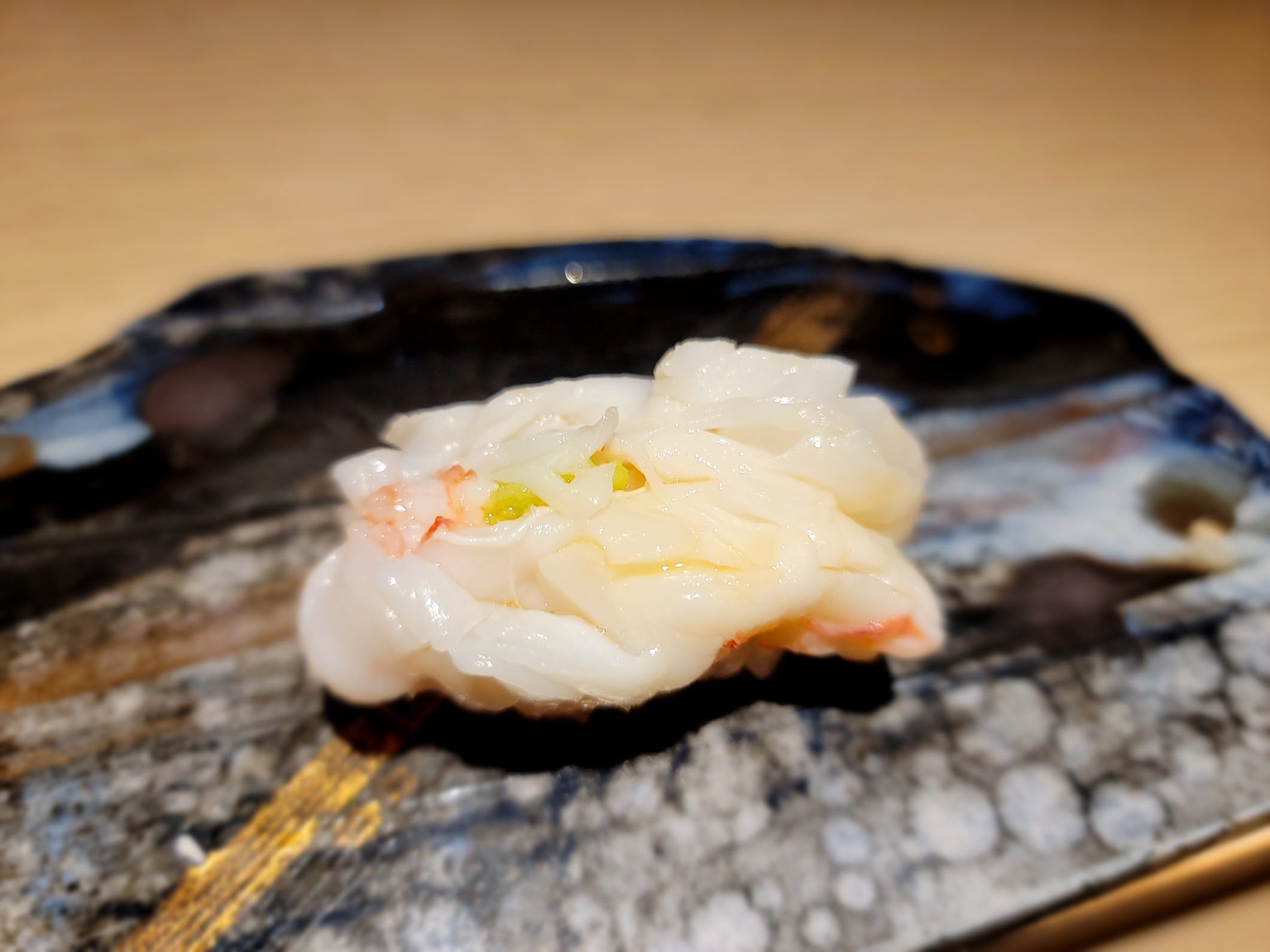
On the other hand, he didn’t serve his tomago that night. The last time we were there he sent us home with a bag to go with our morning coffee, since he knows that I love it.
The quality of fish at Kyoten – easily $250 food cost per person in food cost – is impossible to beat. That’s not an everyday meal, which is good, because it’s not every day you can get a booking. But if you love sushi, are near Chicago, and can afford it then Kyoten is worth the trip.

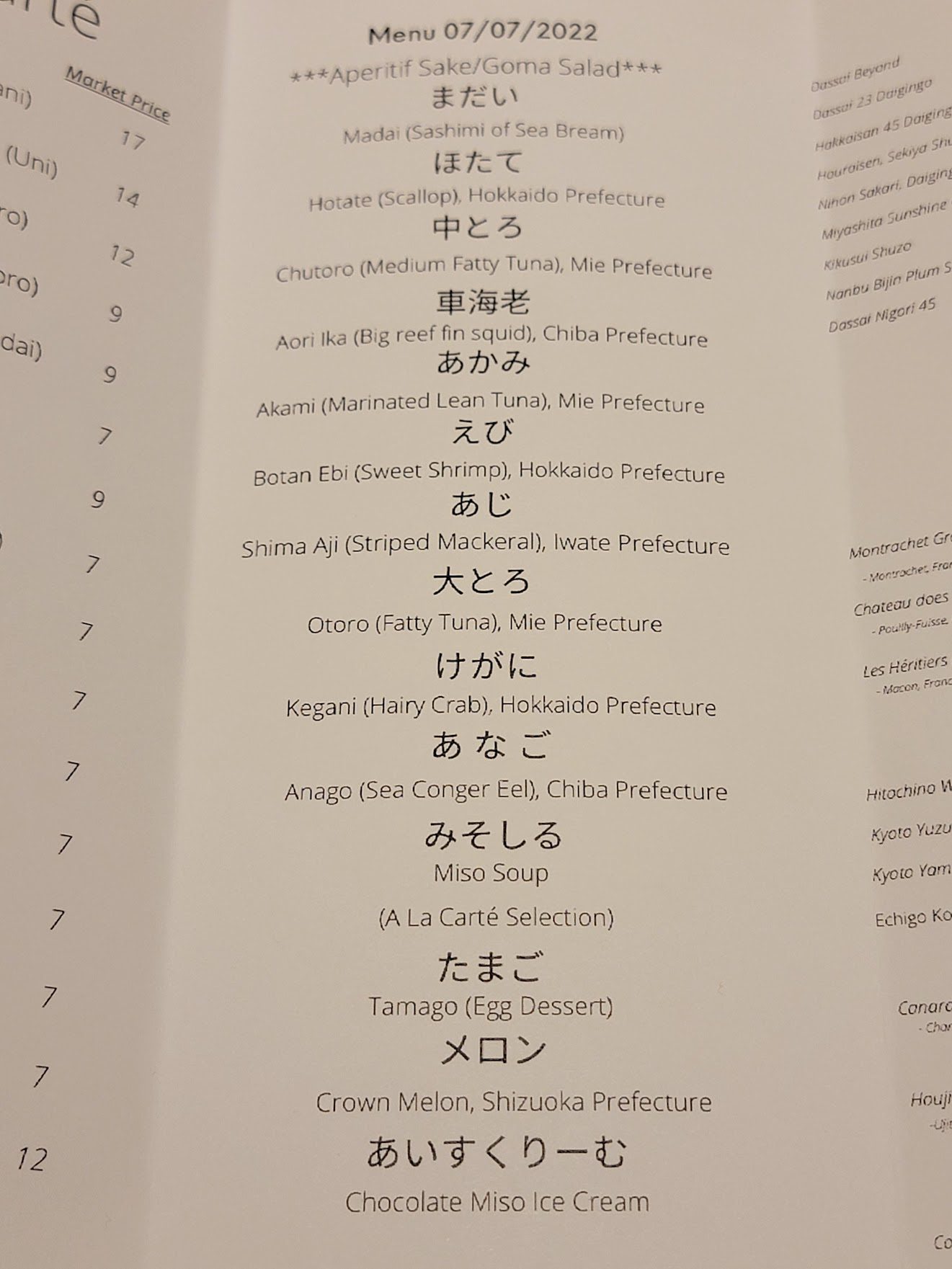

Your single-handed crusade to convince us that Austin is a major metropolis is commendable, if not a little bit sad.
First, BBQ is extremely unhealthy. We’ve always known red meat is unhealthy but the last decade of research has cemented just how bad it is for our health. Compared to a plant based diet where meats are only poultry, and eaten sparingly — for the average person, red meat increases the chance of cardiac problems, cancer, and all cause mortality by double digit percentage points. Red meat is toxic and an educated person should stay away from it as much as possible. Notice I have not even touched upon the ethical considerations surrounding the treatment of animals or the impact of red meat production on climate change.
Second, sushi is never cheap, but there is perfectly good sushi in every major metro area at pennies on the dollar compared to the prices quoted here, which are an abomination. Paying hundreds of dollars for a meal just doesn’t make financial sense. Meals are fundamentally sustenance. I would rather invest in “peak experiences” — I actually learned that term from Gary Leff himself. Now of course, if you make 8 figures of income then knock yourself out with expensive sushi (up to appropriate limits of mercury consumption). But readers of this blog are poor slobs in the middle class chasing AA Loyalty Points so they have a snowball’s chance of getting upgraded to a seat they have no chance of ever being able to afford at retail price. Expensive sushi should not be a consideration.
Third, as a member of an ethnic group of a restaurant that Gary Leff has praised effusively on this blog in the past, I do not trust Gary Leff’s recommendations for ethnic foods. This isn’t a jab at Gary Leff. Western people don’t have the same palate as Asians and don’t even know what real Asian food tastes like.
Excellent review. Thanks Gary.
On your recommendation, I had a birthday dinner at Kyoten Sushiko 5 years ago and it was one of the most memorable meals of my life. We did the early seating mid week and amazingly, we were the only two there. Chef Phan served us a feast.
I look forward to trying Tsuke Edomae.
@Actual Statistician
“Western people…….. don’t even know what real Asian food tastes like.”
So what does Japanese food in Japan taste like to a Westerner compared to let’s say an Indian or Filipino?
@Actual Statistician,
I bet your a lot of fun a parties.
While I agree that Gary is not an authority on food, I do agree with @ABC that it’s extremely unlikely that there exists a “pan Asian” palate such that a Malayalee will be particularly tuned into Lanna foodways or, for that matter, to Marathi food. Everyone’s entitled to an opinion; Gary has his.
Additionally, the notion that red meat is unhealthy is fashion, not science or health advice. It seems to be popular among the “feud is fuel and taking pleasure in it is immoral” crowd, as well as a strain of western Protestantism that introduced the world to eating corn for breakfast in order to avoid the “carnality” that might arise from eating meat.
Finally, I have no idea how @Actual Statistician (who doesn’t seem to me to think very much like an. . . actually statistician) has any insight into the economic situation or eating habits of the readers of this blog. If I had to guess, though, they are substantially wrong in their guess as to who’s reading.
@Actual Statistician — Wow! Your expressed attitudes are quite concerning!
#1. “Red meat is toxic and an educated person should stay away from it as much as possible.” —
So how does an “educated person” define “toxic”? Water is also “toxic” if you drown in it!
#2. “… impact of red meat production on climate change.” —
ROFLMAO! This statement just shouts to me that you are NOT educated about Pollution, Weather, or the Climate! Do you know the differences among these three words? Upon what ACTUAL scientific evidence are you basing your claim? Keep in mind that those TOTALLY FLAWED climate models have NO CREDIBILITY, so do NOT even try to use those as your crutch!!
#3. “Meals are fundamentally sustenance. I would rather invest in ‘peak experiences’ … Expensive sushi should not be a consideration.” —
So I guess you’re mandating that some people can NOT treat a fancy sushi meal as one of their desired “peak experiences”? What happened to personal preferences? Everyone MUST now conform to YOUR definition of “peak experiences”?
#4. “… readers of this blog are poor slobs in the middle class chasing AA Loyalty Points so they have a snowball’s chance of getting upgraded to a seat they have no chance of ever being able to afford at retail price.” —
“Readers are poor slobs”? How did you ascertain this tidbit? Are you also a “poor slob” for reading this blog? Just so you know — I’ve NEVER chased ANY of those AA Loyalty Points. I’ve paid full fare for F/J tickets before. I’ve also gotten many FREE upgrades to F/J tickets for both domestic as well as international flights. And I still DO read this blog. So I guess I must be one of those “poor slobs,” huh? Well … I may be considered as “poor” but perhaps not a “slob”?
#5. “Western people don’t have the same palate as Asians and don’t even know what real Asian food tastes like.” —
I’ve heard this claim so many times, it’s NAUSEATING — what a racist claim! When I frequented Las Vegas in the past, I often went to a very upscale Japanese restaurant in one of their famous casinos, with a superb Sea Bass dish that was their signature offering. Guess who the Exec Chef there was? She was from MEXICO but had trained under a certified Japanese Exec Chef in order to gain her credentials! Do you think that she might have an understanding of what “real Asian food” tastes like?
As a side question — what, exactly, is your definition of “real Asian food,” anyway? I had thought that “real Asian foods” consisted of wide diversities of dishes among great numbers of different ethnic cuisines? Does being an “expert” with one ethnic cuisine, therefore, automatically make one into an “expert” with all of those other cuisines, too? What qualifies to be “the same palate as Asians” when so many different Asian palates exist, even among all Asians, themselves?
Just checked and they are sold out through September for reservations. Ill have to keep checking back right before the new dates are open (it seems they release reservation slots a few days before, e.g. June 26 for July 1-September). Thanks for the tip though since I’ve lamented no good sushi since I moved to Texas from DC-area.
What a terrible post. So much bs could only come from an American. Please stay in the USA, don’t come to Japan ever. That’s why nobody likes Yankees. Phan btw is Vietnamese,not Japanese…
Holy ignorance…. Out of this blog forever
Kimio Izuka, Osaka
If you’re in the mood to try something else, Sushi|Bar recently opened their Austin location I believe. They received a Michelin star last year in California(Montecito & Encino). My favorite overall omakase experience and worth the try(always get the last seating).
Good post Gary. Having been to many of the same places, I never had a problem with the rice falling apart when I picked it up like I did at Tsuke, interesting observation.
@kimio – Phan being Vietnamese has nothing whatsoever to do with the quality of his sushi, you torch any credibility with this commentt.
$499 for a plate of sushi . . . not today.
Good posts from both StrictlyFacts and ActualStatistician.
@One Trippe – it is not a ‘plate of’ sushi.
@ Gary. Haha. Apologies to the sushi purist. How about flat “dish” typically used for serving, pardner?
@ Gary. BTW, there are still plenty of folks in 78704, and 78758 (although probably less) that would still call any sushi “bait”.